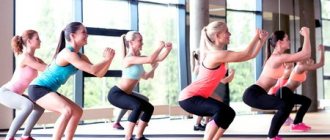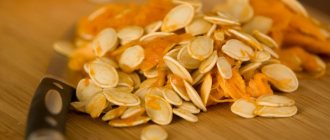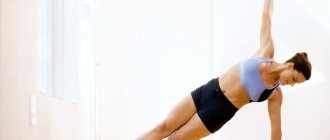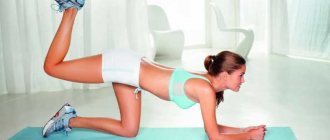Benefits for the body
What are the benefits of stretching for women?
And in order for a person to become significantly more flexible and slimmer, it is necessary to do stretching. And if you stretch constantly, you can eventually perform difficult exercises with ease. In addition, stretching has a very positive effect on daily, everyday life. That is, thanks to these exercises, you can expand your range of motion, which you can perform with ease without all sorts of tension. Another benefit of stretching is that during the process of stretching the muscles, you will burn as many kilocalories as during aerobics. However, as much energy as possible will be conserved. And if you do stretching, muscle stretchability increases. Then it will be less possible to get injured.
The benefits of stretching for men and women
With age, most people lose flexibility, joint mobility decreases, and muscle discomfort increasingly appears. This greatly reduces the quality of life - even normal bending and turning of the head can cause severe pain.
Stretching exercises help lengthen muscles and make the ligaments connecting them more elastic. Thanks to this, freedom of movement and strength of the joints are preserved, and, therefore, everyday life is significantly easier. It's safe to say that stretching prolongs youth.
When performing exercises from the stretching complex, muscle fibers are activated by contracting in response to stretching. A reflex reaction from the nervous system stimulates processes in the muscles and ligamentous-tendon apparatus.
Stretching is the best way to prevent the development of arthrosis, osteochondrosis, and improve the condition of the spine. But its benefits are not limited to this. Regular exercises contribute to the harmonious development and strengthening of all systems and functions of the body:
- improve blood circulation;
- normalize blood pressure;
- increase immunity;
- stimulate digestion;
- balance the hormonal system;
- improve posture;
- relieve stress, insomnia, psychological pressures;
- increase performance;
- develop coordination;
- help you lose weight.
When doing stretching, the muscles alternately relax and tense, helping to quickly relieve tension, relax, and restore lost strength.
Stretching brings enormous benefits to girls and women:
- improves the menstrual cycle;
- helps to tolerate PMS symptoms more easily;
- relieves pain during menstruation.
When performing stretching exercises, blood circulation in the pelvic area increases, which increases libido and strengthens the pelvic floor muscles. In the future, this will prevent such unpleasant phenomena as urinary incontinence or uterine prolapse.
Stretching also provides significant benefits to men - exercise stimulates the adrenal glands and testicles, increasing testosterone production. Full functioning of the hormonal system and increased blood flow in the pelvic organs have a positive effect on potency and prevent the development of prostatitis and infertility.
Stretching will allow women and men to lead an active lifestyle for many years, strengthening and naturally healing all systems of the body.
There are several types of stretching, each of which is based on different methods of tensing and relaxing muscles.
- Traditional (static). It is usually used after training to relieve muscle tension (and as an independent form of fitness). A certain stretching pose is held for 30-60 seconds, then the body smoothly returns to its original position.
- Dynamic. Maintaining the static position at the end point occurs after several repetitions of slow springing movements.
- Ballistic. The muscles are stretched through dynamic swinging movements or flexion of the torso, performed with a large amplitude.
- PNF stretching (proprioceptive neuromuscular). A type of therapeutic muscle stretching. Used to restore joint mobility after injury or surgery. The muscle must first be tensed for 6 seconds, then brought into a static stretch position for 10-30 seconds.
- Actively isolated. The essence of this method is to tense and stretch the muscle opposite to the one that needs to be stretched. Each exercise is repeated 8-12 times. Allows you to strengthen weak muscles or restore them after injury. Less painful compared to traditional stretching.
- With a partner. A variation of static stretching that involves the assistance of another person. Useful for stretching tight muscles that are difficult to work out on your own.
- Aerostretching. Stretching muscles on hammocks in the air. Thanks to its use, it is possible to significantly reduce the load on the joints, relax the spine, and use more muscle groups. The exercises are not suitable for beginners as there is a high risk of injury.
You can combine several stretching methods in one workout or stick to just one.
There is no type of stretching that would suit absolutely everyone. We all have different builds, different levels of physical fitness and set different goals for ourselves. Therefore, you just need to experiment with different methods, choosing the one that is most comfortable.
1. Flexibility training improves the overall condition of the muscles and makes them stronger. Static stretching exercises are the most difficult, as the body needs to pass the pain threshold and get used to it, but they are also the most effective. By overcoming discomfort for some time and withstanding tension, the body rejuvenates.
2. By developing your own body, making it flexible and flexible, you are ensured the safe performance of strength exercises, since insufficiently flexible ligaments can cause injuries and sprains.
3. With regular stretching exercises, your ligaments and tendons become elastic and are able to move with greater amplitude.
4. Stretching exercises allow you to solve many problems, including complexities. Your posture and your entire body will be aligned, you will not feel stiffness in your muscles, your gait will become easy and confident. How much you can tell about a person by his gait, especially for girls and women this is very important. Stretching exercises gradually straighten problem areas and solve problems with the health of the back, joints and other muscle groups.
5. Regular muscle stretching has a beneficial effect on your sex life. This can be done through constant training and exercises to develop the muscles of the legs and hips. Be sure that with each new victory your sexual function increases and your external attractiveness increases.
6. If you perform stretching exercises efficiently, then within a certain period of time it is quite possible to solve problems with internal organs. For example, improve metabolism, speed up metabolism and improve blood circulation.
7. You can do stretching exercises before or after training. Stretching before training allows you to warm up your muscles and avoid injury, but before doing this you must warm up your muscles and ligaments. Stretching after exercise will calm your muscles and gradually reduce blood flow to your muscles. It is optimal to stretch after aerobic or strength training, when the body is already warmed up.
8. A flexible body means not only physical health and beauty, but also inner peace and self-confidence.
You can see that there are quite a lot of advantages to stretching exercises. But it is important to understand that for the best results you need to approach training competently, therefore, you should systematically approach this issue and learn more about stretching.
There are two ways to stretch muscles - static and dynamic. Both of them increase muscle elasticity, but the result is achieved by different methods.
Static stretching is an exercise where you need to stretch the muscle fibers as much as possible and hold the pose for 10–20 seconds, and then slowly return to the starting position. Over time, the muscle will “remember” its new ability, and its extensibility will increase. The advantage of the static method is that it is safer than the dynamic one and is recommended for beginners.
Dynamic stretching is more suitable for experienced athletes and supporters of active cardio exercises (walking, running, swimming): muscle fibers are not stretched by slow effort, but due to the inertia of movement, overcoming natural resistance (for example, during spring lunges or bending over with weights). Its disadvantage is that it is done “through pain” and can lead to injury. However, the benefits and harms of dynamic stretching are mutually balanced if you follow safety precautions and training rules.
The importance of stretching for male athletes is sometimes underestimated. Many men believe that doing the splits and stretching is a woman’s job, while for men, muscle strength and defined muscles are more important. However, professionals know that stretching increases the endurance of the ligamentous-muscular system and its ability to recover, and develops joints.
Stretching is used by men:
- to increase the efficiency of power loads. Overexertion causes muscles to become stiff and their fibers shorten, which reduces range of motion and increases the risk of injury;
- for rehabilitation after injuries, reducing pain and relieving cramps after a hard workout.
- for muscles that are accustomed to forceful loads, and in this case, stretching is both training, rest, and the ability to prevent blood from stagnating with minimal effort.
In outdoor sports, stretching is recommended to improve dexterity and coordination.
It is customary to distinguish 7 types of stretching
Static
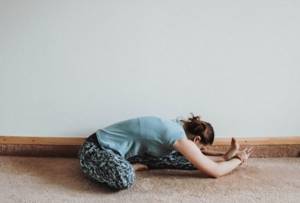
The most popular and safest stretch. Take the desired position and hold for 30 seconds to 2 minutes. We concentrate on the sensations in the muscles: there should be a feeling of stretching, NOT pain. We do not allow jerks, we deepen the pose slowly, barely noticeable.
Passive
As in static stretching, we take the desired position. But we stretch not due to the effort of the muscles being worked, but with the help of a partner or the pressure of our own hands. An example of passive stretching is when the trainer presses on the student's back in a seated bend. Passive stretching is not as effective and functional as static stretching: it does not allow you to work antagonist muscles and is more suitable for relaxation. In addition, this type is not very safe when working with a partner, since you do not fully control the situation, and the inexperience or excessive rigidity of the trainer can lead to injury.
Dynamic
This is rather a warm-up warm-up, although it is classified as stretching. Example: leg swings, side lunges in dynamics. Safe, but not very effective, since the muscles do not have time to relax and stretch enough for the amplitude to increase by any significant amount.
Ballistic
A type of dynamic stretching. The most traumatic stretch, but at the same time quite effective. The movement occurs in jerks, the amplitude increases due to inertia. Since this makes the movement less controlled, there is a risk of spraining.
Isometric
The spring principle is used: relaxation and tension alternate quickly. For example, when you enter the splits, you spring up and down in a small amplitude, either slightly straining or relaxing your muscles.
Active isolated
Provides both stretching and muscle pumping. We take a position of strength and fix it: for example, we raised our leg and hold it.
Proprioceptive neuromuscular stretch
It is a combination of dynamic and passive stretching. Effective and quite pleasant. You get into the right position, your partner puts pressure on you, and you resist. After 20-30 seconds, as you exhale, you relax and your partner “pushes” you to your maximum amplitude.
For example, in Butterfly, your partner puts pressure on your knees, you engage your inner thighs, not allowing yourself to stretch to maximum amplitude, and then relax, and your partner brings your knees to the floor.
Benefits for pregnant girls. What is she like
1. Stretching the inner thigh muscles after squats. Stand with your back straight. Smoothly transfer your body weight to your left knee, bending your leg and turning your toes away from you. Then you need to lean your chest on this knee, and smoothly move your right leg back, sliding along the floor. Raise the foot of your left foot and touch it with your right hand. Stay in this position for about a minute, then perform this exercise, changing legs.
2. Stretching the calf muscles is performed while standing, with your back straight. Place the toe of one foot on a raised platform, while the heel should sag. Stay in this position for a minute, then repeat with the other leg.
3. Stretching the lower back muscles after deadlifts. Lie on your back, stretch your arms along your body. Place your palms on your buttocks. When performing this exercise, you should feel the maximum muscle stretch. Hold this position for a minute, and then return to the starting position.
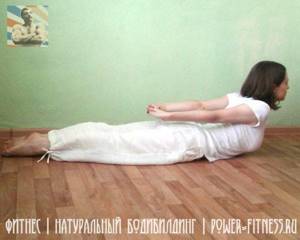
boat
5. Stand against a wall. Raise your arm bent at the elbow above your head, resting your elbow on the wall. As you slide downwards, stretch your triceps to the maximum. Remain in this position for a minute, then repeat this exercise with the other hand.
Muscles that are used to being in good shape can reduce the load on the spine during pregnancy, and the natural process of childbirth is much easier. Also, after the birth of a child, restoring your previous shape will not be difficult; it will be easier for your muscles to tone up.
It's no secret that negative and negative emotions destroy the body on a physical level and also disrupt the functioning of individual organs. This is due to the fact that hormones produced in stressful situations should encourage muscles to work; this is a natural process inherent in nature. During physical activity they are consumed and then eliminated.
Simple stretching helps maintain youth and health. Good luck with your training!
Best regards, Arina Klishina
So what are the benefits of stretching for women? It is known that during pregnancy a huge load is placed on the spine. Any doctor can tell you this. Therefore, if you play sports and at the same time stretch, you can greatly reduce the load on the musculoskeletal system. And also the birth itself in this case is much easier. After childbirth, the muscles become toned faster. But there is one condition - you need to exercise so that there is a good stretch.
The main thing that stretching is useful for girls is the flexibility of the body, thanks to which the female body can more easily cope with its specific functions and problems. When thinking about a weight loss program, start it with stretching - it does not require good physical preparation, but in the future it will help you perform strength exercises to burn calories. They affect the body as follows:
- Orange peel and fat deposits in women are usually deposited on the stomach and thighs, and they are quite difficult to deal with. Stretching, especially the splits, tightens the abdominal and leg muscles without using force.
- Girls and women with elastic muscles are less likely to have painful periods, they are not bothered by PMS, and menstrual irregularities are less likely to occur.
- Elastic muscles reduce the load on the spine during pregnancy, and after pregnancy the muscles more easily recall their normal state. Female gymnasts know well the benefits of cross splits - their childbirth is easier.
There are special exercises that are recommended to be performed while expecting a baby. For example, “Butterfly” - it will prepare the hip joints for serious stress during childbirth, reducing the likelihood of birth injuries in the baby and ruptures in the mother. During pregnancy, it is better to exercise in a group under the guidance of a trainer or via video.
Contraindications
Stretching has many advantages; it is a very useful direction. But at the same time, it has strict contraindications that cannot be ignored:
after recent fractures and injuries. A load is created on the musculoskeletal system, which can result in repeated destruction of the integrity of the structures. You cannot stretch until complete recovery; you can only do it after your doctor’s permission;
- for inflammation and chronic joint diseases;
- for any diseases of the spine and muscular system;
- with dysfunction of the cardiovascular system;
- if you experience unexplained pain while doing stretching exercises.
We looked at how stretching is useful for women, who can and cannot do it. With the right approach, it will become a unique tool for promoting health and maintaining the beauty of the body.
Benefits for psychological well-being
It is believed that if a woman experiences negative emotions, the body is destroyed as a result, and in terms of the physical component, the hormones that it produces in such situations push the muscles to work. Therefore, it is necessary during this period not to eat stress, but to engage in physical activity.
And if you don’t exercise at this moment, eventually the body begins to break down due to the release of hormones. And if the muscle tissue is in tension - tone, the brain receives information that the body is in the process of work. Then the consequences of stress will not take place in a person’s life.
The benefits of muscle stretching are great. Even due to the fact that it allows the muscles to be elastic and not subject to various injuries, as happens in people who do not play sports at all.
Types of stretching
With regular exercise you can change your figure for the better. Stretching affects the body in four directions at once:
- reduces the volume of problem areas;
- improves posture by strengthening the back muscles;
- tightens the muscle frame;
- forms thin and long muscles, making the figure more graceful.
Extra centimeters on the waist and hips are formed not only due to fat deposition. Due to poor lymphatic drainage and blood circulation, fluid accumulates in these places. These are the main causes of cellulite.
Daily stretching improves blood flow in tissues. Oxygen enters the stuck together fat cells, accelerating metabolic processes and lymph outflow. By doing stretching, the volume of problem areas will gradually decrease, and the “orange peel” effect will become less pronounced.
Thanks to stretching, the body will become graceful, like a ballerina. In combination with strength and cardio exercises, the benefits for your figure from stretching will increase - the desired proportions can be achieved even faster.
Stretching exercises reduce the appearance of cellulite because they help remove excess fluid from the intercellular space, improve blood flow, and enhance the functioning of the lymphatic system. Stretching strengthens the muscle corset of the whole body, making your figure more prominent day after day.
What are the benefits of stretching for girls?
Many trainers recommend stretching before strength or cardio training, active games or competitions. But research shows that stretching does not improve strength, power and speed in various types of exercise, and in some cases even reduces it. This depends on the length of the stretch: if you stay in one position for more than 60 seconds, the performance deteriorates, and the longer a person stretches, the more they fall.
Additionally, research shows that stretching before exercise does not reduce the risk of injury. And with particularly conscientious work, it even increases flexibility.
Before intense training, you don’t need stretching, but an active warm-up: running in place, swinging your legs and arms, bending over, etc. This kind of warm-up copes with the main tasks: to increase the performance of the main training and reduce injuries. This is due to the fact that active movements increase the speed of transmission of impulses to working muscles, blood flow in them, which means faster delivery of food for energy and removal of waste (for example, lactate).

Therefore, high flexibility as such, in itself, is not needed. It is useful only in those types of physical activity where it is required as an element of movement, for example, in gymnastics and dancing.
During flexibility exercises, both muscles and tendons are stretched. But joints and ligaments should not be involved in this, and if they are stretched incorrectly, they can be harmed. To prevent this from happening, do not lock your joints when taking a stretching pose: that is, keep your elbows and knees slightly bent. Plus, you're more likely to injure yourself if you push yourself too hard and suffer pain (rather than just a stretched feeling).
– You need to study in a comfortable environment. It is best to do this in a place where you will feel calm and there will be no distractions. When performing exercises, you need to relax and enjoy, and at the same time try to strain the part of the body to which the physical activity is directed.
– Experts recommend doing static exercises, that is, staying in one position for half a minute.
– Significant benefits of stretching muscles, as well as ligaments, will be visible if you do not accelerate the physical activity and do not immediately start the exercises. This is especially true for beginners. With each workout, you first need to warm up the muscles so as not to injure them.
– There is no need to strive to get results as quickly as possible. After all, such a desire can lead to serious consequences. In the event that a person does everything to the point of pain, this is a signal from the muscles or tendons that the person is very tense. You need to understand that this is painstaking work.
Therefore, you should work carefully. If you do such stretching exercises daily, the body will eventually get used to it and only then can you increase the load. Over time, you can get the desired result. But you shouldn’t strive to get stretching like gymnasts as quickly as possible. After all, under strong tension, unprepared muscles can crack, and this will lead to injury. In this case, you will need to repeat everything from the very beginning later.
– To get results, it is best to do stretching before the main workout, as well as after. This way the muscles can quickly get used to the load. As a result, they will become much more elastic.
There is one more important rule: for exercises to be effective, you need to stretch every day. So the result will be faster. Then the effect will be better and there will be excellent stretching.
How to stretch correctly?
The same rules apply to all areas:
- Before performing stretching exercises, you should warm up. Without it, there will be a high risk of injury;
- Breathing plays an important role, it cannot be held, you need to breathe through your nose, if deep breathing is required, then through your mouth;
- There's no need to rush. With measured movements, muscle rigidity becomes lower, excess tension disappears;
- it is necessary to monitor the intensity of movements. In static forms, you cannot make sudden movements; this is the fastest way to injure soft tissues. In addition, a sharp jerk at a moment of strong muscle tension will lead to severe pain.
There is one more important rule; it has nothing to do with the organization of the training process, but with its perception. You can't compare your progress to other people's stretching. The temptation will be especially high for those who study in a group; you should not give in to it. Each person has their own flexibility potential and body structure.
Therefore, how quickly the effectiveness will be noticeable is an individual question.
It is best to stretch before or after the main workout; light stretching can be a relaxing remedy before bed. With moderate loads, you can stretch every day, but you shouldn’t be overzealous and do it several times a day. The optimal frequency is daily or every other day.
With the right approach, stretching can be done even during pregnancy. The rules for pregnant women are set out in the article “When and how to properly stretch a pregnant woman?”
Does stretching help you lose weight?

Stretching itself is not an energy-consuming activity. The number of calories burned in 1 hour of training is no more than 150. They can easily be replenished by eating a couple of apples.
However, stretching helps you lose weight. But for this you need to combine classes with cardio and strength training. When muscles are more elastic and joints are more mobile, the range of motion increases significantly. By performing exercises in which amplitude affects calorie expenditure (for example, squats, leg swings), you can burn much more body fat with good stretching.
Stretching helps increase the effectiveness of intense workouts for fat burning and reduces body volume by reducing accumulated fluid in problem areas.
Stretching during training
Remember how a cat wakes up: it sags, and then arches its back. In the same way, a person who got out of bed in the morning or sat at his desk in the evening wants to stretch, stretch his stiff muscles, without thinking about why he needs stretching.
Introduce stretching exercises into your morning exercises, and you will feel how after 10-15 minutes of exercise you will gain strength and improve your mood. Stretching helps the body get into working mode: blood circulation is activated, blood flow to the muscles and brain increases, and muscle tension goes away.
You may not be able to do the splits quickly, but you will soon notice the benefits of stretching in your daily life:
- Agility and mobility. In slippery weather, a person with good stretching is less likely to lose balance, and for those who are interested in dancing, it becomes easier to learn new figures. Elastic muscles obediently change the position of the body in space and easily learn unusual movements.
- Improved posture. Constantly tense, stiff muscles of the lower back, back, shoulders and chest worsen posture, especially in people with sedentary work (in modern medicine there is the concept of “posture while sitting on a chair”), and habitual incorrect body position increases the risk of spinal diseases. Stretching teaches muscles to relax and quickly become toned.
- Resistance to stress. Stress not only affects our mood, but also affects the physiological functions of the body: emotional tension and overwork provoke muscle tension. However, the opposite relationship has also been scientifically proven - muscle relaxation has a healing effect on the psyche and helps restore mental balance.
Regular stretching exercises help improve the well-being and health of older people: they prevent joints from becoming stiff and muscles from becoming rough. Stretching is also beneficial for diabetes: physical activity helps regulate blood sugar levels, but not all diabetics are allowed active exercise.
Stretching increases the impact of strength loads and reduces the likelihood of damage to muscles and joints, so it should be included in both the warm-up (after warming up) and the cool-down. These can be hatha yoga asanas, exercises from qigong or other eastern practices, plus dynamic exercises.
How exactly to stretch at the beginning of a session depends on its purpose. It is believed that static stretching before strength training reduces muscle strength and reduces endurance (for example, during sprinting, barbell exercises or exercises on blocks), while dynamic stretching does not affect muscle strength and strength.
A sharp cessation of physical activity is harmful to warm muscles, and a cool-down helps them cool down slowly and recover faster for the next activity. Static stretching is used as a cool-down.
Stretching after exercise helps prevent injury and speed up the recovery process. During physical activity, the muscles contract, returning to their original state not immediately, but within several days. Without recovery, they are unable to build strength and maintain the intensity of training. Stretching at the end of the session helps bring muscle tissue back to its original state much faster.
If you don't stretch after a workout, muscle recovery is delayed, which means the effectiveness of the exercises decreases. This leads to stagnation in the growth of strength and endurance.
So, stretching after training helps:
- reduce the recovery time of muscles and joints;
- reduce pulse, restore blood pressure;
- relieve muscle tension by reducing soreness (muscle pain after physical activity);
- stimulate muscle growth;
- reduce stress on the body after intense exercise.
Stretching after training should be spent 10-15 minutes, stretching all muscle groups involved in the exercises.
Stretching should be a mandatory final stage of strength or cardio training. It helps improve the physical capabilities of the body and avoid injury. You shouldn’t neglect stretching to save time.
boat
How to do static stretching
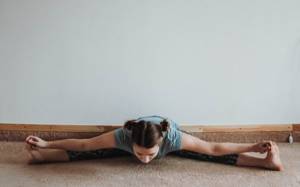
Let's look at the safest and most popular way to develop flexibility. This algorithm is suitable for static stretching in any position.
- Take the desired position in a way that is comfortable for you. Do not try to immediately “jump” into a split or a bend - this is ineffective and unsafe.
- Regulate your breathing: it should be slow and rhythmic. Try to breathe more from your stomach than from your chest - this will help you relax.
- As you exhale, begin to gradually deepen the pose. Without jerking, smoothly, allowing the body to get used to each new stage. Your movement may be visually almost imperceptible - this is normal.
- Continue to help yourself with your breathing: each stretching-relaxation occurs precisely on exhalation, and on inhalation - fixation. Try to exhale into those places where you feel tension - direct your attention there.
- Bring the position to your comfortable limit - that is, there should be NO pain, only a feeling of tension. It is also usually unpleasant, but not painful - it is important to distinguish these sensations.
Stay at this final point for 10-30 seconds. The entire exercise should take you 30-45 seconds, maximum 2 minutes.
The benefits and harms of stretching. Execution Rules
Stretching is a universal type of fitness that can be practiced by men and women of any age, with different levels of physical fitness. But with certain diseases, stretching muscles and ligaments can cause harm rather than benefit.
Contraindications to stretching are:
- exacerbation of chronic diseases, especially arthrosis, intervertebral hernias, radiculitis;
- fractures and dislocations - injured ligaments and bones are not compatible with stretching exercises;
- disturbances in the functioning of the cardiovascular system associated with the risk of thrombosis;
- acute period of viral diseases (with an increase in body temperature).
During pregnancy, stretching is not contraindicated for women if there are no complications or threats associated with this condition. Stretching exercises will only bring benefits: they will prepare the body of pregnant women for the upcoming birth, reduce back pain, swelling, and facilitate the recovery period. Many gynecologists recommend stretching every day while expecting a baby.
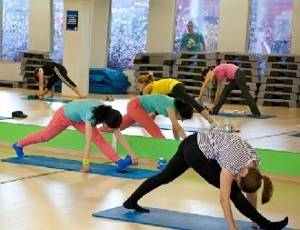
There are only some restrictions due to the increasing volume of the abdomen - you cannot perform exercises that compress the internal organs (for example, bending while standing).
Therefore, the ideal time for stretching is after strength training, or better yet, cardio training. If you devote a separate session to stretching, doing a warm-up is a must. 10-15-minute cardio is suitable: running, burpees, steps from classical aerobics (important - with the active participation of the arms, you can take light dumbbells of 1-2 kg). Pulling unheated muscles is not only less effective, but also dangerous.
An hour is the maximum. In 30-40 minutes you will ensure a full stretch of the whole body and will not overwork it. If you perform stretching solely for the purpose of relaxing “clogged” muscles and preventing their shortening, then generally 15-20 minutes after the main workout will be enough. But, of course, you won’t break your personal flexibility records.
The optimal option is 3-4 times a week, regardless of whether you stretch as a separate workout or as an addition to strength training and cardio. Don’t overdo it: you don’t need a full-fledged flexibility workout every day—the muscles should also have time to recover from thorough stretching, just like from strength training. Infrequent exercise, in turn, will not produce any effect.
From neck to ankle. Not focusing on one split or leaning towards your feet is important not only for the harmonious development of the body. The fact is that individual stretching exercises involve more muscles than we used to think. For example, for the same cross split, you need to pull not only the inner surfaces of the thighs, but also the lower back - without this you will not be able to do a full split.
Tense muscles, in principle, do not stretch; the effect of such training is an illusion. Relaxation is ensured by two conditions.
First, moderate load. There is no need to stretch in the maximum position available to you: if you are in pain, the body reacts to it as to any stress - with mobilization, tension. Therefore, the sensations should be unpleasant, but quite tolerable. If you lose your breath and want to get out of the pose as quickly as possible because you don’t have the strength to endure it, moderate your ardor.
Secondly, you need enough time to relax. Therefore, we hold each pose for at least 30-45 seconds. 3-4 approaches for each muscle group are enough.
Correct breathing
Make sure you don't lose your breath. It should be slow and rhythmic. A good relaxing technique that allows you to deepen the stretching is to exhale into those places where you feel pain and tension. Just direct your attention there, exhaling, feel how the muscles gradually become softer and more pliable.
Vlada Isakova, yoga instructor
It is difficult to say what harm stretching can cause. After all, such exercises, if done correctly, should not lead to negative consequences. But the benefits of stretching are much greater. You need to know some rules to make it safer.
– You shouldn’t think that stretching is a warm-up – it’s not at all. As mentioned above, if you stretch muscles that are not warmed up, you can end up getting injured. Therefore, you need to do light exercises before it. It's best to stretch after a workout.
– You should not strain your muscles if you engage in very active activities. For example, intense running, swimming. Research suggests that stretching before physical activity can reduce your ability to perform well.
– You can’t finish stretching very quickly and abruptly. Since this can cause significant harm to the muscles and the person himself. It is best to stay in one position for half a minute. This way the muscles can get used to this exercise.
– Some people think that stretching is painful. But experts and athletes advise not to do exercises until you feel pain.
– It is necessary to stretch those muscles that were involved in the training. After all, after classes they are most warmed up.
Exercise safety
To properly stretch, you need to train in a comfortable environment.
To do this, you need to choose a quiet place where you can practice yourself and use the following tips.
- Before performing the main exercises, you need to warm up your muscles by walking, running or riding an exercise bike.
- It is not advisable to stretch to the point of intense activity.
- When performing the complex, it is better to focus on the main muscle groups:
- Hips;
- Necks;
- Shoulders;
- Calf;
- Lower back.
- It is necessary to stretch muscles and joints alternately.
- You should not end the exercises abruptly, so that small tears do not form in the muscles.
- It is necessary to maintain tension until the pain threshold is felt.
- Stretching the muscles should be done regularly, at least twice a week, so as not to lose their shape.

